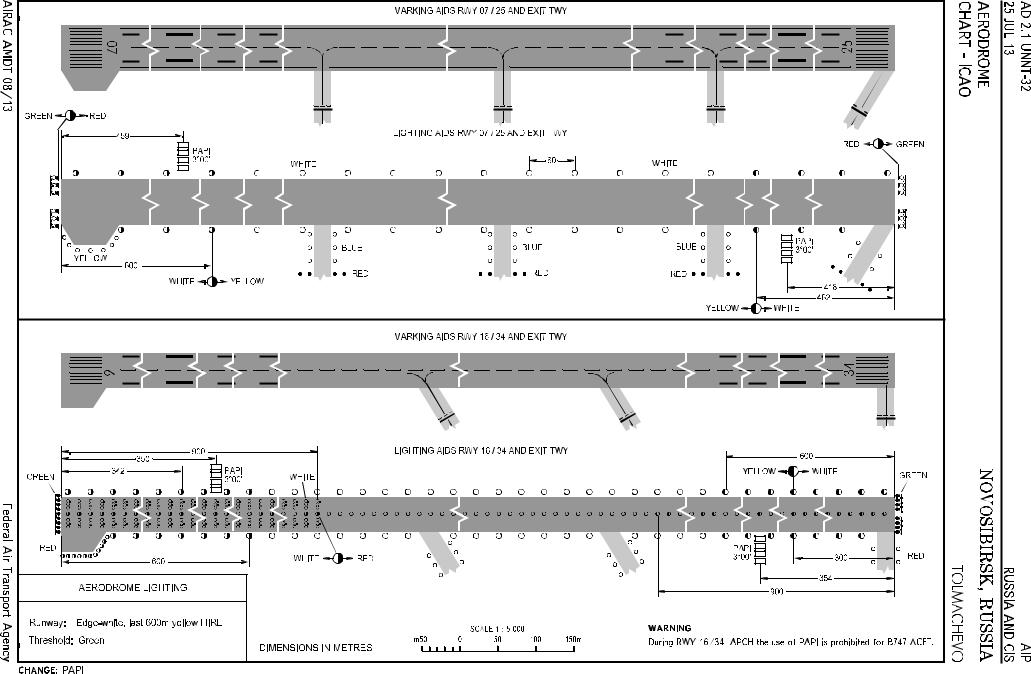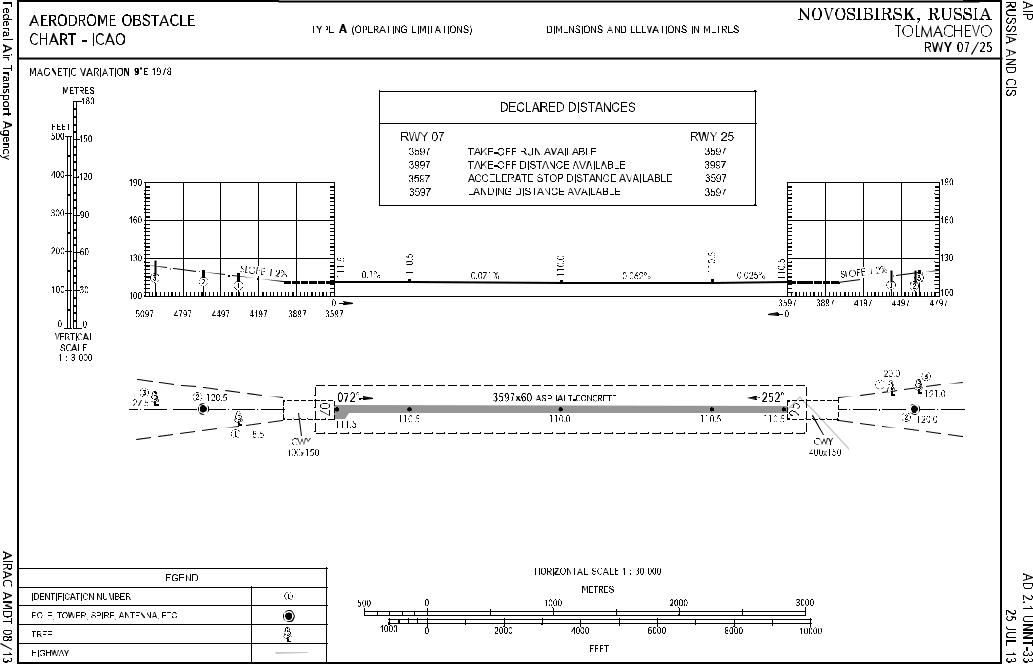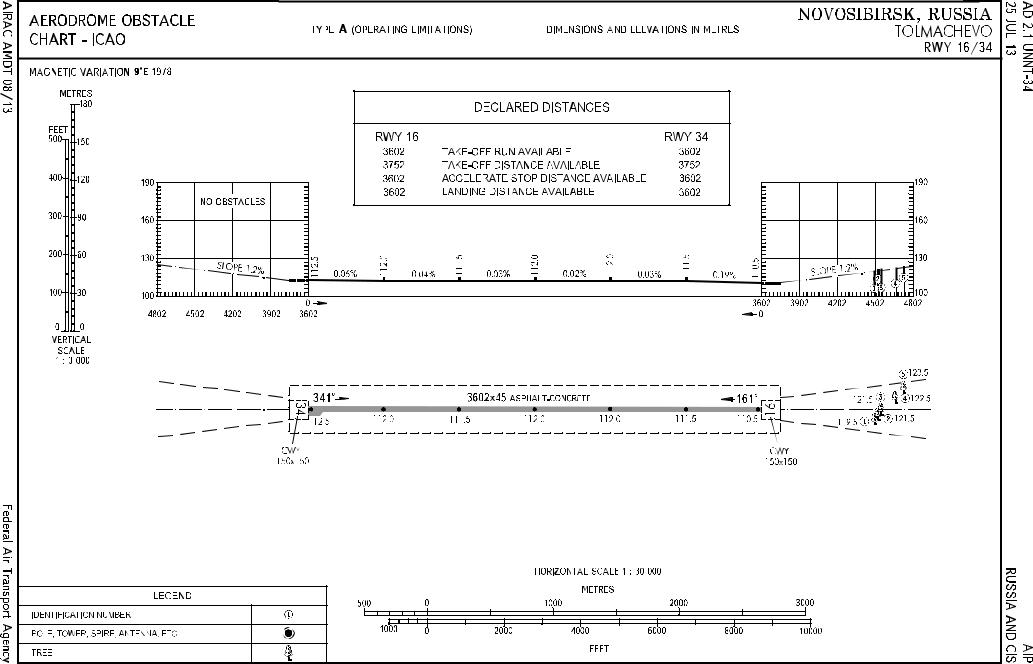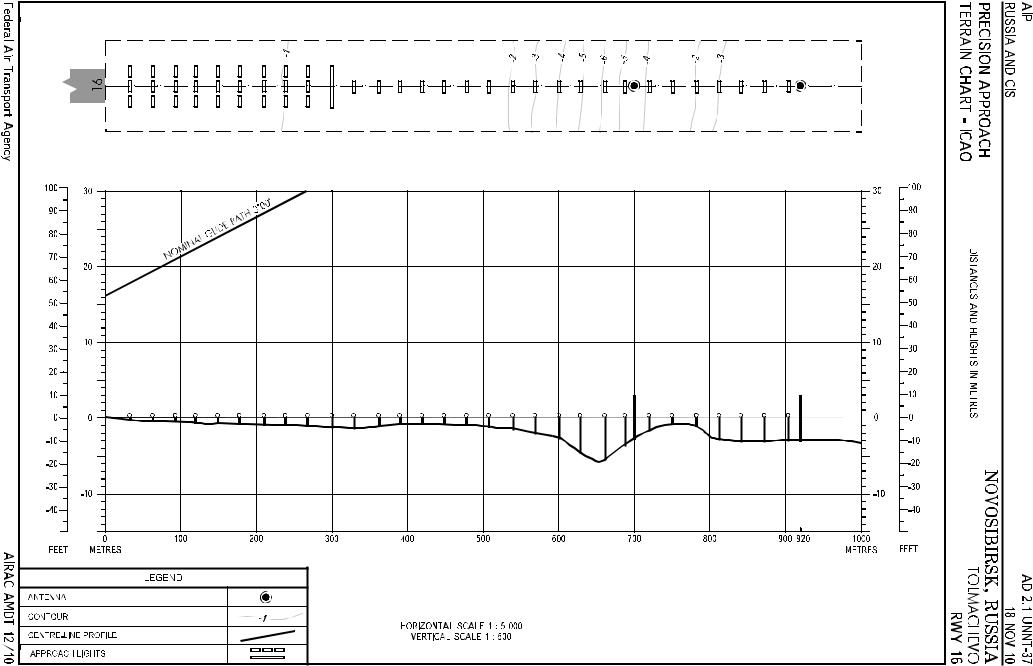

AD 2.1 UNNT-12 |
AIP |
10 JAN 13 |
RUSSIA AND CIS |
Запуск двигателей производится по разрешению руководителя буксировки. Ответственность за безопасность буксировки с запущенными двигателями несут руководитель буксировки и КВС.
Запрещается буксировка ВС с запущенными двигателями по скользкому перрону.
Запрещается буксировка ВС с запущенными винтовыми двигателями.
Руление (буксировка) производится по указаниям диспетчера руления. Скорость руления выбирается командиром ВС в зависимости от состояния РД, наличия препятствий, взлетной массы ВС, ветрового режима и условий видимости. Во всех случаях скорость руления не должна превышать скорости, установленной руководством по летной жксплуатации ВС. Ответственность за соблюдение правил руления несет КВС.
Заруливание ВС на тяге собственных двигателей разрешено:
−на МС 4А, МС 49-51 (носовой частью на юг), МС 58-61, 1А, 5А (носовой частью к ИВПП);
−на МС 31-33, МС 1Л, МС 36Л, при условии отсутствия ВС и оборудования на МС, находящихся на пути руления самолетов;
−на МС 2-4, МС 36-38 (при установке ВС носовой частью к аэровокзалу), при условии, что на стоянках (МС 6-13), попадающих под воздействие газовой струи рулящего самолета не производится коммерческое и техническое обслуживание ВС.
Через РД B заруливание ВС на тяге собственных двигателей разрешено на МС 12-17, при отсутствии ВС
иоборудования на МС, находящихся на пути руления.
Вслучае руления ВС через РД A, РД C, РД D, заруливание на МС 12, 13-17 разрешается при условии, что на стоянках (МС 6-13), попадающих под воздействие газовой струи рулящего самолета не производится коммерческое и техническое обслуживание ВС.
Заруливание на МС 12А и 14А осуществляется на тяге собственных двигателей через РД B с последующей установкой тягачом по разметке при условии свободных МС 11, 12, 13 для заруливания на МС 12А и свободных МС 12, 13, 14 для заруливания на МС 14А.
Через РД D заруливание ВС на тяге собственных двигателей разрешено на МС 56:
− для ВС Ан-124 при условии свободных МС 33,
41;
− для ВС B747, B777, B767, DC-10, Ил-86, Ил-76
при условии свободной МС 33.
Выруливание на тяге собственных двигателей разрешено:
− с МС 58-61 (носовой частью к РД D), МС 5-29, 31-33, 34-35, 41, 42, 48, 1А-5А, 52-54, 55-57, 1Л через МС 51, 36Л через МС 4А при условии, что на смежной стоянке, попадающей под воздействие газовой струи выруливающего самолета, не производится коммерческое и техническое обслуживание ВС.
При наличии самолетов на площадках для хранения ВС (за МС 18-26) выруливание ВС на тяге собственных двигателей с этих МС запрещено.
Разрешается установка тягачом, а также заруливание и выруливание на тяге несущего винта (без разворотов в пределах зоны обслуживания) вертолетов типа Ми-8 и ниже на МС 58-61. Вертолеты типа Ми-26 устанавливаются только тягачом.
Engines start-up shall be carried out by the permission of the towing superintendent. The responsibility for the safety of towing with started-up engines rests with the towing superintendent and the pilot-in-command.
Towing of aircraft with started-up engines is prohibited on the slippery apron.
Towing of aircraft with started-up turboprop engines is prohibited.
Taxiing (towing) shall be carried out by the instructions of the Taxiing controller. The speed of taxiing shall be chosen by a pilot-in-command depending on condition of TWY, the presence of obstacles, the aircraft take-off mass, wind mode and visibility conditions. In all cases the speed of taxiing shall not exceed the speed established by the Aeroplane Flight Manual. The responsibility for the observance of taxiing rules is imposed on the pilot-in- command.
Taxiing of ACFT is allowed under own engines power into the following stands:
−into stands 4A, 49-51 (facing south), 58-61, 1A, 5A (facing the RWY);
−into stands 31-33, 1L, 36L on condition that there are no ACFT and equipment on the stands located on the way of ACFT taxiing ;
−into stands 2-4, 36-38 (when ACFT are parked facing the terminal), on condition that commercial and technical service of ACFT does not take place on stands (stands 6-13) affected by the engine jet blast of the taxiing ACFT.
Taxiing of ACFT into stands 12-17 under own engines power is allowed along TWY B on condition that there are no ACFT and equipment on the stands located on the way of ACFT taxiing.
In case of ACFT taxiing along TWY A,, TWY C, TWY D, taxiing into stands 12, 13-17 is allowed on condition that commercial and technical service of ACFT does not take place on stands (stands 6-13) affected by the engine jet blast of the taxiing ACFT.
Taxiing into stands 12A and 14A shall be carried out under own engines power along TWY B with subsequent parking under assistance of a tow tractor along the marking on condition that stands 11, 12, 13 are vacant for taxiing into stand 12A and stands 12, 13,14 are vacant for taxiing into stand 14A.
Taxiing into stand 56 is allowed under own engines power along TWY D as follows:
−for An-124 ACFT when stands 33, 41 are vacant;
−for B747, B777, B767, DC-10, Il-86, Il-76 ACFT when stand 33 is vacant.
Taxiing out of the stand under own engines power is allowed as follows:
− out of stands 58-61 (facing TWY D), stands 5-29, 31-33, 34-35, 41, 42, 48, 1A-5A, 52-54, 55-57, 1L via stands 51, 36L, via stand 4A on condition that commercial and technical service of ACFT does not take place on adjacent stand affected by the engine jet blast of the taxiing ACFT.
When pads for storage of ACFT (behind stands 1826) are occupied, taxiing of ACFT under own engines power out of these stands is prohibited.
Stands 58-61 are AVBL for parking of Mi-8 type HEL or class below under assistance of a tow tractor as well as taxiing into/out of the stands under the main rotor power (without turning within the service area). Mi-26 type HEL shall be parked only under assistance of a tow tractor.
AIRAC AMDT 01/13 |
Federal Air Transport Agency |

AIP |
AD 2.1 UNNT-13 |
RUSSIA AND CIS |
27 JUN 13 |
7. Применение процедур выполнения полетов в условиях ограниченной видимости
Процедуры выполнения полетов в условиях ограниченной видимости (LVP) вводятся при дальности видимости на ВПП (RVR) 600м и менее по указанию диспетчерской службы.
Процедуры применяются в целях:
−предотвращения столкновений ВС в условиях ограниченной видимости;
−предотвращения столкновений ВС с препятствиями на земле в условиях ограниченной видимости;
−обеспечения защиты критических зон курсового
иглиссадного маяков при выполнении полетов по категории II ИКАО и взлетов в условиях ограниченной видимости;
7.1 Прилет
Экипажам ВС гарантируется, что сигналы курсового и глиссадного радиомаяков полностью защищены от помех при нахождении ВС на конечном участке захода на посадку с момента объявления о введении процедур ограниченной видимости до момента их отмены.
Диспетчером органа ОВД экипажу каждого прибывающего ВС дополнительно должна передаваться следующая информация:
−до выхода на конечный участок схемы захода на посадку − текущие значения дальности видимости и высоты нижней границы (вертикальной видимости) на ИВПП посадки;
−данные об отказах любых компонентов средств для САТ I, II.
ВС должны выводиться на луч курсового радиомаяка при заходе по ILS не менее, чем за 4км от точки конечного этапа захода на посадку (FAP).
Для обеспечения точности сигнала ILS, на конечном этапе захода на посадку между ВС диспетчером ОВД формируются интервалы не менее 15км.
При смешанной эксплуатации одной ИВПП эшелонирование при заходе на посадку должно быть организовано так, чтобы вылетающее ВС пролетало над курсовым радиомаяком до того, как заходящее на посадку ВС достигает удаления 4км от торца ВПП.
После посадки в условиях ограниченной видимости на ИВПП-16 экипаж ВС обязан доложить диспетчеру органа ОВД о производстве посадки, освобождении ВПП и критической зоны.
Прибывшее ВС встречается машиной сопровождения.
7.2 Вылет
Руление по перрону и по РД осуществляется с разрешения диспетчера только за машиной сопровождения до РД или предварительного старта.
При необходимости диспетчер органа ОВД может потребовать от экипажа ВС доложить отрыв ВС от ИВПП фразой «Взлет разрешаю», доложите отрыв»
(“Cleared for take-off, report airborne”).
7. Low Visibility Procedures.
Low Visibility Procedures (LVP) shall be implemented when the runway visual range (RVR) is 600 m or less by ATC instruction.
The procedures shall be applied for the purpose of:
−avoiding the aircraft collision in low visibility condi-
tions;
−avoiding the aircraft collision with obstacles on the ground in low visibility conditions;
−providing protection of LOC and GP critical areas when operating ICAO CAT II operations and executing take-off in low visibility conditions.
7.1Arrival
The flight crews are guaranteed that the LOC and GP signals are protected completely from the interference, when the aircraft is on the final approach from the moment of introduction of LVP till the moment of cancellation of LVP.
The following information must be transmitted additionally to the flight crew of each arriving aircraft by ATS unit controller:
−current values of RVR and ceiling (the vertical visibility) for the runway of landing – before establishing on the final approach track;
−the information about failures of any components of the facilities for CAT I, II operations.
The aircraft must intercept the localizer beam during ILS approach at a distance of not less than 4 km from FAP.
The ATS controller shall form the intervals of not less than 15 km between the aircraft on final approach to provide the accuracy of ILS signal.
During mixed operation of one runway the separation during the approach procedure must be organized so that the departing aircraft should fly over the localizer before the landing aircraft reaches the distance of 4 km from the runway extremity.
After landing on RWY 16 in LVP the flight crew must report the ATS unit controller about the execution of landing, vacation of the runway and critical area.
The landed aircraft shall be met by a “Follow-me” vehicle.
7.2 Departure
Taxiing along the apron and TWY shall be carried out by permission of the controller only after the “Follow-me” vehicle to the taxiway or to the runway-holding position.
If necessary the ATS unit controller can request the flight crew to report the lift-off using a phrase “Cleared for take-off, report airborne”.
Federal Air Transport Agency |
AIRAC AMDT 07/13 |

AD 2.1 UNNT-14 |
AIP |
27 JUN 13 |
RUSSIA AND CIS |
УННТ АД 2.21 ЭКСПЛУАТАЦИОННЫЕ ПРИЕМЫ СНИЖЕНИЯ ШУМА.
Часть I
ЭКСПЛУАТАЦИОННЫЕ ПРИЕМЫ СНИЖЕНИЯ ШУМА НА ЭТАПЕ ВЫПОЛНЕНИЯ ВЗЛЕТА И
НАБОРА ВЫСОТЫ
1. Общие положения.
Эксплуатационные приемы снижения шума на этапе взлета и набора высоты выполняются экипажами всех ВС. Выполнение приемов снижения шума не производится за счет снижения уровня безопасности полетов. Выполнение эксплуатационных приемов не производится в случае отказа на этапе взлета одного из двигателей ВС.
2. Ограничения.
Ограничения по предельным боковым и попутным составляющим ветра - согласно РЛЭ каждого типа ВС.
Разрешается производить взлет с сухой и мокрой ИВПП, при Ксц≥0.3.
При AСN=64R/C/X/T: ВС типа Ан-124 и B747 до-
пускается не более 2-х взлетов в сутки, ВС ДС-10 - один взлет в сутки. Допускается одновременный прием не более одного ВС типа Ан-124.
3. Специальные процедуры взлета.
При выполнении взлета с МК=72º первый разворот выполняется на удалении 2 км от выходного порога ИВПП (4 км по DМЕ). При возникновении аварийной ситуации на ВС после взлета (при уходе на 2-й круг) и невозможности захода на посадку по установленной схеме, экипаж выполняет стандартный разворот и производит посадку на ИВПП с обратным курсом;
-при взлете с МК=72° выполняется отворот влево на МК=350°, затем правым разворотом на МК=252° или в зависимости от удаления от ВПП выполняет разворот влево до МК=170° с последующим разворотом на МК=252°;
-при взлете с МК=252º выполняется стандартный разворот вправо для захода на посадку с МКпос=72°.
Часть II
ЭКСПЛУАТАЦИОННЫЕ ПРИЕМЫ СНИЖЕНИЯ ШУМА НА ЭТАПЕ ЗАХОДА НА ПОСАДКУ
1. Общие положения.
ЭксплуатационныеприемысниженияшуманаэтапесниженияизаходанапосадкувыполняютсяэкипажамивсехВС.
ВПП 07 является предпочтительной ВПП, которая по возможности используется для захода на посадку.
2. Ограничения.
Ограничения по боковым и попутным составляющим ветра - согласно РЛЭ каждого ВС. Разрешается производить посадку на ИВПП при Ксц≥0.3.
Заход на посадку с прямой разрешается с МКпос=72° при условии занятия эшелона перехода до удаления ≥ 30 км. Полеты ВС над центральной частью города на высоте ниже (1200)м - запрещены.
UNNT AD 2.21 NOISE ABATEMENT PROCEDURES.
Part I
NOISE ABATEMENT PROCEDURES DURING TAKE-
OFF
AND CLIMBING PHASE
1. General provisions.
Noise abatement procedures during take-off and climbing phase shall be executed by crews of all aircraft. Noise abatement procedures shall not be executed at the expense of reduction of flight safety. Noise abatement procedures shall not be executed in case of failure of one of the aircraft engines during take-off phase.
2. Restrictions.
Restrictions on maximum cross-wind and tail-wind components are as in accordance with the Aeroplane Flight Manual for specified aircraft type.
It is allowed to take off from dry and wet RWY when friction coefficient is 0.3 or more.
When ACN is 64R/C/X/T, not more than 2 take-offs of An-124 and B747 type aircraft and one take-off of DC10 for twenty-four hours are permitted. Simultaneous arrival of not more than one An-124 type aircraft is permitted.
3. Special take-off procedures.
During take-off on heading 72°MAG the initial turn shall be carried out at 2 km from RWY departure threshold (4 km DME). In case of aircraft emergency after take-off (during missed approach) and if unable to carry out the established approach procedure, the crew shall carry out procedure turn and land on RWY with reciprocal heading;
-during take-off on heading 72°MAG a turn-away to the left shall be made onto track 350°MAG, then right turn onto track 252°MAG or depending on a distance from the RWY turn to the left shall be made to track 170°MAG with subsequent turn onto track 252°MAG;
-during take-off on heading 252°MAG a right hand procedure turn shall be made for approach-to-land on heading 72°MAG.
Part II.
NOISE ABATEMENT PROCEDURES
DURING APPROACH PHASE
1. General provisions.
Noise abatement procedures during descending and approach phase shall be executed by crews of all aircraft.
RWY 07 is noise preferential and shall be used for approach to the greatest extent possible.
2. Restrictions.
Restrictions on cross-wind and tail-wind components are as in accordance with the Aeroplane Flight Manual for the specified aircraft type. It is allowed to land on RWY when friction coefficient is 0.3 or more.
Straight-in approach is allowed on landing heading 72°MAG when transition level has been reached before a distance of 30 km or more. Flights of aircraft over the central part of the city at below (1200)m are prohibited.
AIRAC AMDT 07/13 |
Federal Air Transport Agency |

AIP |
AD 2.1 UNNT-15 |
RUSSIA AND CIS |
27 JUN 13 |
3. Специальные процедуры захода на посадку.
Аварийная посадка производится на рабочую ИВПП с рабочим направлением или с курсом обратным посадочному в зависимости от возникшей ситуации. Для посадки с убранными шасси на грунт используется грунтовая площадка расположенная севернее ИВПП 07/25 и непосредственно к ней примыкающая.
УННТ АД 2.22. ПРАВИЛА ПОЛЕТОВ.
Общие положения.
В узловом районе аэродрома Новосибирск/Толмачево полеты осуществляются по ППП или ПВП. Переход от полетов по ППП к полетам по ПВП осуществляется по разрешению органа ОВД.
Процедуры полетов по ППП.
Полеты по ППП выполняются на заданных эшелонах (высотах) в соответствии с правилами вертикального и продольного эшелонирования с выдерживанием установленных интервалов. Ответственность за обеспечение установленных интервалов и назначение безопасных эшелонов возлагается на органы ОВД. Для регулирования очередности захода на посадку диспетчерам дано право задавать траектории полетов ВС в пределах своих зон ответственности с соблюдением установленных ограничений.
Потеря (отказ) радиосвязи.
В случае потери (отказа) радиосвязи экипаж действует в соответствии с процедурами отказа радиосвязи, изложенными в Приложении 2 ICAO и разделе GEN 3.4.5 настоящего AIP. В случае потери радиосвязи в узловом районе аэродрома экипаж ВС обязан:
-включить сигнал бедствия;
-принять все меры к восстановлению радиосвязи, используя все средства и каналы связи, аварийную частоту 121.5 МГц, радиосвязь с другими ВС и пунктами ОВД;
-если радиосвязь установить не удалось, ночью - периодически обозначать себя включением фар;
-продолжать передачу информации о месте нахождения, высоте полета и своих действиях;
-прослушивать на частоте ДПРМ указания диспетчера;
-оценить метеоусловия и возможность перехода на полет по ПВП и принять решение о продолжении или прекращении полета;
-при невозможности перехода на ПВП, следовать по ППП на аэродром посадки на заданном эшелоне, полученном перед потерей радиосвязи, выйти на ДПРМ, выполнить маневр по схеме зоны ожидания со снижением до высоты круга, произвести посадку;
-при заходе на посадку на 4-ом развороте и после пролета ДПРМ обозначить себя и запросить посадку миганием, а затем включением посадочных фар.
В случае потери радиосвязи после взлета ВС, экипаж производит посадку на аэродроме взлета. Если по условиям погоды посадку выполнить невозможно, занять высоту попутного нижнего безопасного эшелона или эшелон FL140−150, или FL240−250 в зависимости от направления полета и следовать на запасной аэродром.
3. Special approach procedures.
Emergency landing shall be carried out on the run- way-in-use on the runway-in-use heading or on the reciprocal heading depending on the arisen situation. Grass field, located north of RWY 07/25 and directly adjoining it, is available for landing on grass with retracted landing gear.
UNNT AD 2.22 FLIGHT PROCEDURES.
General provisions.
Flights in Novosibirsk/Tolmachevo TMA shall be carried out according to IFR and VFR. A change from IFR flights to VFR flights shall be executed by ATS unit permission.
IFR flight procedures.
IFR flights shall be operated at assigned flight levels (altitudes) in accordance with the rules of vertical and longitudinal separation maintaining the established intervals. The responsibility for providing the established intervals and assignment of safe flight levels is placed on ATS units. For regulating the approach sequence the controllers are given the right to assign flight tracks within their areas of responsibility with observing the established restrictions.
Radio communication failure.
In case of radio communication failure the crew (pilot) shall follow radio communication failure procedures stated in ICAO Annex 2 and GEN 3.4.5 of the present AIP. In case of radio communication failure in TMA the crew shall:
-switch on a distress call;
-take all measures on reestablishing the radio communication using all available facilities and communication channels, emergency frequency 121.5 MHz, radio communication with other aircraft and ATS units;
-if radio communication failed to be restored, identify oneself by periodically switching on lights at night;
-continue the transmission of information on aircraft position, flight altitude and actions taken;
-continue listening watch to the controller’s instructions on LOM frequency;
-assess meteorological conditions and the possibility to change to a VFR flight and make a decision on continuation or aborting the flight;
-if unable to change to a VFR flight proceed according to IFR to the aerodrome of landing at the assigned flight level cleared before radio communication failure, proceed to LOM, execute holding procedure descending to aerodrome traffic circuit height, carry out landing;
-during approach procedure on final leg and after crossing LOM identify oneself and request landing by flashing and then by switching on landing lights.
In case of radio communication failure after take-off the crew shall carry out landing at the aerodrome of departure. If due to weather conditions it is impossible to carry out landing the aircraft shall reach the lower safe level of the same direction or flight level FL140−150 or FL240−250 depending on the flight direction and proceed to the alternate aerodrome.
Federal Air Transport Agency |
AIRAC AMDT 07/13 |

AD 2.1 UNNT16 |
AIP |
27 JUN 13 |
RUSSIA AND CIS |
Процедуры полетов ПВП в диспетчерском районе аэродрома.
При полетах по ПВП необходимо иметь двухстороннюю радиосвязь, разрешение соответствующего органа ОВД, полет выполняется только при визуальном контакте с землей. ПВП предусматривают выдерживание установленных интервалов между ВС без изменения заданной высоты (эшелона), а при полете ниже нижнего эшелона, кроме того, выдерживание истинной безопасной высоты, выдерживание установленного маршрута (схемы) с помощью визуальной ориентировки и с использованием имеющихся навигационных средств.
УННТ АД 2.23 ДОПОЛНИТЕЛЬНАЯ ИНФОРМАЦИЯ.
Район аэродрома характерен наличием заболоченных территорий и пойм рек, на удалении 12 км с северо-восточной стороны водный рубеж р. Обь. Это обуславливает большое скопление птиц в районе аэродрома и их сезонные миграции. Птицы перелетают летное поле на высоте до 300 м. В период сезонных миграций (весна, осень) птицы пересекают аэродром в северном и южном направлениях на высотах до 3500 м.
При обнаружении скопления птиц информация немедленно передается экипажу ВС. Получив информацию о скоплении птиц, КВС включает посадочные фары, усиливает осмотрительность.
VFR flight procedures within CTA.
During VFR flights it is necessary to have two-way radio communication, a clearance of appropriate ATS unit, a flight shall be operated only with visual reference to the ground. VFR provide for maintaining the established intervals between aircraft without changing the assigned altitude (flight level) and during flights at heights below the lower flight level, besides that maintaining absolute safe altitude, adherence to the established route (flight pattern) with assistance of visual orientation and using the available navigation facilities.
UNNT AD 2.23 ADDITIONAL INFORMATION.
The aerodrome area is characterized by the existence of marshy territories and the flood plains. The Ob river is located at 12 km on the north-eastern side. It conditions a large concentration of birds in the vicinity of the aerodrome and their seasonal migrations. The birds cross the airfield at heights up to 300 m. During seasonal migrations (spring, autumn) the birds cross the aerodrome in the northbound and southbound directions at heights up to 3500 m.
When the concentrations of birds are detected, the information shall be immediately transmitted to the crew. On receiving the information about the concentration of birds the pilot-in-command shall switch on landing lights, increase caution.
AIRAC AMDT 07/13 |
Federal Air Transport Agency |





